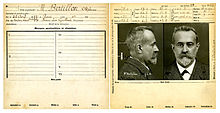This article needs additional citations for verification. (October 2014) |
| Criminology |
|---|
 |
| Main Theories |
| Methods |
| Subfields and other major theories |
| Browse |

Anthropological criminology (sometimes referred to as criminal anthropology, literally a combination of the study of the human species and the study of criminals) is a field of offender profiling, based on perceived links between the nature of a crime and the personality or physical appearance of the offender. Although similar to physiognomy and phrenology, the term "criminal anthropology" is generally reserved for the works of the Italian school of criminology of the late 19th century (Cesare Lombroso, Enrico Ferri, Raffaele Garofalo and Lorenzo Tenchini). Lombroso thought that criminals were born with detectable inferior physiological differences. He popularized the notion of "born criminal" and thought that criminality was a case of atavism or hereditary disposition. His central idea was to locate crime completely within the individual and divorce it from surrounding social conditions and structures. A founder of the Positivist school of criminology, Lombroso opposed the social positivism developed by the Chicago school and environmental criminology.